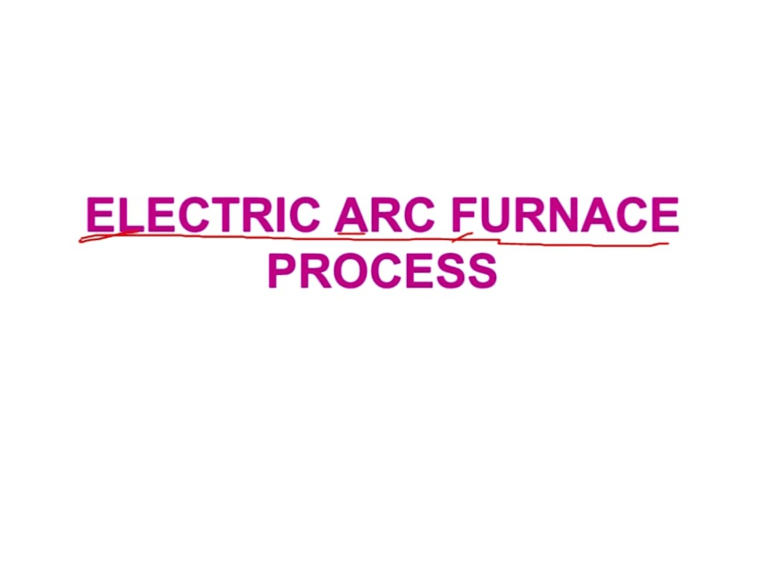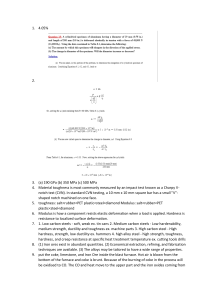
El ECTRIC ARC EURNACE
PROCESS
e::
p
Introduction
y
ijThe EAF has high metallic and ingot yields, coupled with nigh quality of the product.
i
Cost of the steel making is high for this process.
- The EAF capacities were in the range of: 1-50 T, but 10 Tare more popular.
Electric Heating: Electric furnaces are three types:
(1) The resistance furnace
(2) The induction furnace
(3) The arc furnace, it is two types:
(a) Direct heating (used for ferrous extraction process)
Here the current flows from the electrode to the charge and heat is transferred from
the arc to the charge primarily by radiation but a part of the heat is also generated in
the charge itself.
(b) Indirect heating:
Here the arc is struck between two carbon electrodes and the heat is transferred to
the charge by radiation. Hence the steel making temperatures are not generated for
this furnace.
Used ,n non ferrous extraction process like non ferrous foundries.
Recently these are using in some steel scrap melting in ferrous foundries.
Types of EAFs
•
1. Acid EAF : It is used for steel foundries. But not
commonly popular.
2. Basic EAF: Very popular and used for all types
of steel making.
•
Arc furnaces are two types :
-
The roof along with the electrodes swings clearly
off the body to facilitate charging from top.
The roof is lifted a little and the furnace body
moves to one side clearty off the roof to facilitate
charging.
•
The furnace unit consists of the following
parts:
1. Furnace body: The shell, The hearth, The walls,
The spout, The doors etc.
2. Gears for furnace body movements
3. Roof and roof lifting arrangements
4. Electrodes. their holders and supports
5. Electrical equipments - i.e. The transformer, The
cables. The electrode control mechanism etc.
El£CTROOCS
Refractory Lining
SILl:A BRIO<S
HIGM.IU>4INA
BACK R00f'
✓.
W\TER
room
FR»IES
~NT ME
oc.sm
SIi£
WORt<
DOOR
9.JRN[O
MKlNCSJTE--.:
BRICKS
•" •
~
RAMMED MI-Gf'€SIT£
LAVE:R
, SILLA
Ullt'ER
( bl
TttS HALF I'S _ ...,_ THIS HALF ts
BASC UNEO
ACIO UNCD
f' Ii t J ·2. Croa-secboo of an electric arc furnace showing the
details of refractory liou11r The 1tamum t.ype sub-hearth coo.,trucuoo i i shown in (a ) and the invert.eel 1ub-bearth coostroction in Cb).
Types of EAFs
/
1. Acid EAF : It is used for steel foundries. But not
commonly popular.
2. i asic EAF: Very popular and used for all types
of steel making .
•
Arc furnaces are two types:
The roof along with the electrodes swings clearly
off the body to facilitate charging from top.
-
•
12
The roof 1s lifted a little and the furnace body
moves to one side clearly off the roof to facilitate
charging.
The furnace unit consists of the following
parts :
1. Furnace body: The shell, The hearth, The walls,
The spout, The doors etc.
2. Gears for furnace body movements
3. Roof and roof lifting arrangements
4. Electrodes. their holders and supports
5. Electrical equipments - i.e. The transformer, The
cables. The electrode control mechanism etc.
I
n,;. ta I . Elactric arc l\ara.-9 willl ad-J
..sx- i.o--\lMldalalael_....
~
: Lr-..U.ll, S-.J. 0.....4.Spoul. &_ "mt-,..-
1..m.cu...s. 7 Anni»MIPl""".t-'
aoblal. \0 llelf ...._-. 1L El
► .1 f D
11•
11 LINl...._l, n.u'lN
matrol. 12. On ....
CRANE
EL£C TROOE
RAISED -
_nnr
~Ti]~
....
:s,!
0
I
_ __
ELEClROOE
0~ JOINING
___.,
CHARGING BASKET
c DROP - BOTTOM >
lllllNG
MECHANISM
LADLE
Fig. 13· 11. Vertical section of an electric arc furna ce s hop.
The following table indicates some approximate dimensions or
the furnaces :
•
5
0.52
20
4.5
0.72
80
6.0
1.00
150
7.2
L07
0.52
0.30
0.72
0.30
0.72
0.35
0.73
0.36
10
Normal capacity t
•
m
Shell dia
Depth from aill m
2.7
3.S
0.45
Total thickness
m
of hea:rth
Roor thickness m
0.45
0.22
EU:c:1R0UC "5$04111.y
HOR! r
.M"~ SUPPORT
FOP RO<)r U n
ne:TR00l ~DER ASSEMlllY
COUJMN
SUI PORT
lZOtn
T
I >I
(UrtAOO(
Ol~
•
AOOFUFT
ROOrllll~
&
Ccl
SWlt6 M£CIHAN1SM41---A~------=----
D
IIOOf" Llrl
HE:HAH19'1
FUANA.C:E
• 13-6. Co)
Pie. ~ (b).
Vanous l.)i,ec ol roof lift a.nd SW'lDI arranpmaots :
A mul indepeDdeot offu.mau 3hell ia wi.1 in la) and iD (b) it is
1tlach«t riciclly &o the lhell : a tndt and pi.ot i, med for liftinc
and swiotia, the roof in (c).
.. ... . ·~- ...
I
-
Fi& - 13·7. EJectn,de ni pp le joinin1 tw
o
piecea of el ec :tt od N .
Process Types Known by Their Slags
1. Acid Proce:ss.
-
If the raw materials are very low in P and S acid lined furnace can be used for refining,
using an acid slag as in an acid open hearth practice.
-
It is generally restricted to foundries.
2. Basic Process.
- It is capable of refining any type of charge by maintaining basic slag in a basic lined
furnace. Unli ke any other steel making process electric furnace has practically no oxidizing
atmosphere of its own.
-
Oxidizing as well as reducing conditions for refining can be maintained by making slags of
suitable compositions.
-
Oxidizing refining is carried out under a slag containing good amount of iron oxide.
-
Reducirng conditions can be maintained by having the slag highly basic but practically free
of iron oxide.
The following describes the ways in which these slags are used for refining in
an arc furnace:
(I) Oxidizing single slag practice.
•
-
his used for making carbon or low alloy steels of a quality attainable in an open heanh process .
-
The charge is melted and refined under a basic oxidizing slag as in an open hearth.
-
The alloy additions may be made in the furnace or in the ladle.
(II) Oxidizing double slag practice.
-
It is a modification over the single slag practice. The early slag is removed and a similar new slag is
made again to obtain effective desulphurization and dephosphorisation during refining.
(Iii) Reducing single slag practice.
-
It is used for high alloy steelmaking to effect maximum recovery of alloying elements from the scrap.
Hardly any refining take place.
-
Carbon and phosphorus contents in the scrap must be well below the specification levels since these
will not be removed during refining.
-
Sulphur however could be readily removed in tlhis practice since the conditions are reducing.
/
((iv) Oxidizing slag con'(erted to Reducing .
-
It is meant to remove carbon but recover most of the alloying contents like Cr, Mn. etc.
in the scrap during high alloy steel making.
-
Phosphorous content of the charge needs to be below the specification level , since it
will otherwise revert back to the metal during the reducing period.
(v) Double slag practice.
-
It means refining under oxidizing as well as reducing slags made separately.
-
The first slag is oxidizing and It eliminates all impurities like P. Si, C, Mn. etc.
-
This slag is removed and a reducing slag is made by fresh additions of lime, coke and
spar to desulphurise the metal and carry out alloying very effectively.
-
The practice is a must if effective desulphurization and the large alloying additions are
to be made.
-
It is costly but the yield of the alloying additions is very high and the quality of the
product is much better.
13·8. General Outline of an Arc Furnace Heat
Although the details of a heat very much depends on local.
conditions, quality of the charge and the product to be produced a..
general outline of a heat is only described• below :
The essential steps are as follows:
1.· Preparation of charge. /
2. Charging. ~
3. Melt-do,,·n. ~ ·
4.
s.
Refining.
Finishing and tapping of single slag heat.
6. Slag-off and making reducing slag.
7. Reducing period,
8. Finishing and tapping of double slag heat.
Old Practices of Stainless steel making
½4·5·t- Con\Pentlonal Arc Furnace Pnetlee or l«•lal~•
SteelmaJc~ng. Steels contuining 12-:= 30% chromium with or without
other alloy11\g etcn,cnts tltc cln.~sccl as stainless atccla. A vut majority
~f th~c steels n1ust contain alrb(ll\ below o· 12%. A IW:SC proportion 1n fact- contains o·o7-ll"08% C and the Ni-Cr series llR mado\\"ilh only 0·0J~.~ l~.
In tl,e early duys,~tnit,lcss steel was made by ad(lilion of low
car!x'>n Fe-Cr lo a refined pluin et1rbon steel bath to make up the
en~re chton,ium specifications. lt wus thus a very_ costly mc~od.
Stainless steel scrap could not be dtatl ,nellt.d ,vilhoul carbon pickup from the arc furnace clcclr(ldc. As a result the scrap could
not be reused cconon1icalty. lt piled up to such an extent that it
become imperative (for the Ni nnd Cr values in the scrap) to develop a proc.ess of n1clting the scrap to produce thcrefo1111, low-carbon stainless steels. By 1931 a process was developed wherein carbon
was oxidised and ,vhnte,•cr cl,romium oxidised concurrently was
later on reduced back to the mctnl phase. The process soon came
to be known as the Rwtlu, process which is still being used '.When
OX)pgen gas is not available for refming. The furnace bottom and
side walls to a height just above the slag line were made of chromebrick to ,vithstand the chemical action of superheated iron oxidcri~ slags. Chrome ore used for fettling the walls soon become a
ma1or source of chromium.
If steel containing low carbon me teq!Jired tW ~ . of
should be· very much lower than um13'. Tho equ1b111imn
~us-ti
eontmtl
·of ~boa aud. chromium in. atee1 in ooattcl with pan
•
Cr-.0,
at f'co= l atoms, at various temperatmos are shown iu
Fig. 14•·2. .P11ting D:fiuing ~e eJecbic ar.c A•roem slag is atmeai
ed with chrom1"·.... x1de a
e ambient atmos here
be·
assumed to be of CO at one atmospheric pressure.
condition
in an arc furnace thus are 0close to those govemin , Fig. 14·2. Tha
• •
data predict
-.....u.
, the equilibrium · carbon ~ntent is 0·22% ,which ii
• need to q·OS% at 1800°C,, The carbon in the molt ca:ri, tbc;r~fore,
& preferentially oxidised from a Fe-C-Cr bath only at much higher
temperatures.
·
~~
~-'+--+-~~~o'-1
-
~
'
r,
~
" .... 1
-t /
,llll--+--1-t+-~,4-,,"~
~
i"'
..,. .. .
r~c:-~1
;,,
+-#,b',l~""+-+--t
Ila-,:·
t
·----=
---- --•CI
·-
( !t a·---
D
15
5
~
CHROMlutot
20
.
Equilibrium carbon and chromium contenta of ltecl
in contact with pure 0 1(?1 under ca;t,on monoxide
at one atmosphere at vanous tempcraturca.
(after Hiltyll)
fr,,>ically the chaT e consisted ot· such i
i
that ~ no.
third of the ~
cation c roJ11um was o
~ ; ; ; ;, . car
ferro-chrome,«;:third from e ro
ore an th~ mmmnLJgt
tbird from the s a1n
• ".auome ore is evenly c
Cit
on the bottom and a ong e ~.u,.s: Light scrap is charged first on
the charge-chrome ore and then the heavy scrap followed by iron
ore, anything upto 15-20% of the heat weight. High carbon F&Cr is charged above the iron ore followed by a little of light scrap.
The reason for adding a large excess of iron ore will be ~tear fromthe following :
·
The free energy temperature relationship of tho reactions! <Cr> +{01}=! <Cr1 Oa>
.•. (14·1)
and
2<C> +{O.}=2{CO}
... (14·2)
indicate that they are at equiliburium at l220°C, t.a. ·_tho lice cnca&f
ehange of the reaction (avoiding fractional powers)
3{C0}+2<Cr> ~ <Cr1 O,> +3 ~C>
••. (14·3)·
la zero .a t 1220°C. The equilibrium constant is
11
1
-
a
/ ,.. :le <Cr1 0 8>
Kll!-aJ
a• <Cr>
a•
. <C>
·fl' {CO}
•



